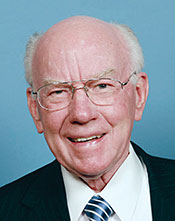First physicist in Congress dies
DOI: 10.1063/PT.3.3726
Vernon Ehlers, who was the first PhD physicist to be elected to Congress, died on 15 August 2017 in Grand Rapids, Michigan. He was 83.
Elected to the House of Representatives in a 1993 special election, Ehlers served his western Michigan district until 2010, when he did not seek reelection. He quickly became an advocate for STEM (science, technology, engineering, and mathematics) education. During hearings of the Committee on Science and Technology, of which he was a member, he often expressed disappointment and concern with the lack of science and mathematics literacy among the general public. In recognition of his scientific training, he was named as the committee’s vice chairman, a title that was largely symbolic.
A Republican, Ehlers was asked in 1997 by then House Speaker Newt Gingrich (R-GA) to produce a national science policy statement. Unlocking Our Future: Toward a New National Science Policy, the 100-page product of the year-long effort, stressed the importance of investing in basic research, urged a cautious approach to the US entering large international scientific projects, and called for improved communication among House and Senate committees that share jurisdiction over large, complex federal technical programs, among other recommendations. Although the report itself had little practical impact, its preparation was an important educational process for the congressional aides who worked on it, notes Michael Lubell, former director of public affairs at the American Physical Society (APS).

Vernon Ehlers
US CONGRESS

Gingrich also put Ehlers in charge of creating the congressional email system and making congressional proceedings available online to the public. Ehlers oversaw the establishment of THOMAS.gov, the online legislative information source which was later renamed Congress.gov.
Lubell recalls how Ehlers in 1998 helped defuse an effort by conservative House members to cut the NSF budget by 10% on the grounds that the agency funded frivolous grants. During the debate, Rep. Mark Sanford (R-SC) cited what he believed were NSF-funded studies of automated teller machines and gambling as examples of wasteful spending. Ehlers went to the floor to inform colleagues that the questionable grant titles actually referred to asynchronous transfer mode, a switching technique once widely used by telecommunications networks, and to Monte Carlo methods, a class of computer algorithms.
Lubell credits Ehlers for getting Republican Science Committee members behind the America COMPETES Act (see Physics Today, September 2007, page 34
Ehlers, who was homeschooled, received his bachelor’s and doctorate degrees in nuclear physics in 1956 and 1960 from the University of California, Berkeley. He then conducted research at Lawrence Berkeley Laboratory before moving in 1966 to teach at Michigan’s Calvin College, which he had attended as an undergraduate for three years. Ehlers was active in APS before entering politics. He served on the first selection committee for the society’s congressional fellowship program in 1973, and he was a member of APS’s Panel on Public Affairs in the late 1970s.
He was elected to the Michigan House of Representatives in 1983 and two years later to the state Senate. Ehlers served there until 1993, when he was first elected to the US House to fill a vacant seat, and went on to win eight more elections.
In a statement, former representative Rush Holt (D-NJ), himself a physicist who worked at Princeton Plasma Physics Laboratory before his election to Congress in 1999, recalled, “Vern welcomed me as the second member of the bipartisan physics caucus, saying we could meet anywhere—even in a phone booth—as long as it had a blackboard where we could discuss such things as the quadrupole moment of the nucleus, or impedance matching of simple machines, or congressional debates.” Holt, now CEO of the American Association for the Advancement of Science, continued, “We amused each other by calculating the growth rate of physicists in Congress, with Vern arriving after about two centuries and me coming six years later; at this rate, we estimated that by the mid 21st century, most of Congress would be made up of physicists.”
Former representative Bart Gordon, the Tennessee Democrat who chaired the Science Committee from 2007 through 2011, recalls Ehlers’s role in the committee’s passage of 151 bills and resolutions during Gordon’s tenure, all of which had bipartisan support. “Vern was a big part of that, because if you made the case to him and he thought you were right, he would not be held back by any partisan views,” he says. “When you convinced Vern something was the right thing to do, that was sort of a signal to other Republicans on the committee.”
More about the Authors
David Kramer. dkramer@aip.org
